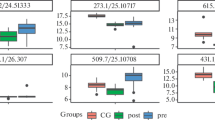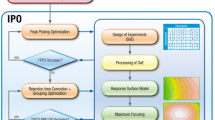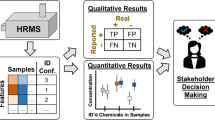Abstract
Optimization of instrumental settings of a triple-quadrupole mass analyzer was performed by Box–Behnken design, support vector machines, and a Pareto-optimality approach. This time-saving, stepped chemometric strategy was used to model the signal response of underivatized human urinary amino acids. Drying gas flow, nebulizer pressure, sheath gas flow, and capillary voltage settings were exhaustively studied beyond the parameters conventionally optimized in triple-quadrupole devices (multiple reaction monitoring transitions, fragmentor and collision energy voltages). The results indicate that the best signal response for high-abundance and low-abundance underivatized amino acids was achieved with drying gas flow of 9 L/min, nebulizer pressure of 60 psi, sheath gas flow of 13 L/min, and capillary voltage of 3000 V. Compared with the widely standardized settings tested, chemometric analysis led to signal intensities 74% and 68% higher for high-abundance and low-abundance amino acids, respectively. The flexibility, speed, and efficiency of this method allows its affordable implementation in all mass spectrometry-based research to obtain superior results compared with those obtained with conventionally optimized mass spectrometry instrumental parameters.






Similar content being viewed by others
References
Cotzias GC, Van Woert MH, Schiffer LM. Aromatic amino acids and modification of parkinsonism. New Eng J Med. 1967;276(7):374–9.
Lipton SA, Rosenberg PA. Excitatory amino acids as a final common pathway for neurologic disorders. New Eng J Med. 1994;330(9):613–22.
Lindroth P, Mopper K. High performance liquid chromatographic determination of subpicomole amounts of amino acids by precolumn fluorescence derivatization with o-phthaldialdehyde. Anal Chem. 1979;51(11):1667–74.
Roth M. Fluorescence reaction for amino acids. Anal Chem. 1971;43(7):880–2.
Alvarez-Segura T, Camacho-Molinero C, Torres-Lapasió JR, García-Alvarez-Coque MC. Analysis of amino acids using serially coupled columns. J Sep Sci. 2017;40(13):2741–51.
Desiderio C, Iavarone F, Rossetti DV, Messana I, Castagnola M. Capillary electrophoresis-mass spectrometry for the analysis of amino acids. J Sep Sci. 2010;33(16):2385–93.
Kaspar H, Dettmer K, Gronwald W, Oefner PJ. Automated GC–MS analysis of free amino acids in biological fluids. J Chromatogr B. 2008;870(2):222–32.
Le A, Ng A, Kwan T, Cusmano-Ozog K, Cowan TM. A rapid, sensitive method for quantitative analysis of underivatized amino acids by liquid chromatography–tandem mass spectrometry (LC–MS/MS). J Chromatogr B. 2014;944:166–74.
Cerdan-Calero M, Sendra JM, Sentandreu E. Gas chromatography coupled to mass spectrometry analysis of volatiles, sugars, organic acids and aminoacids in Valencia Late orange juice and reliability of the Automated Mass Spectral Deconvolution and Identification System for their automatic identification and quantification. J Chromatogr A. 2012;1241:84–95.
Peris-Díaz MD, Alcoriza-Balaguer MI, García-Cañaveras JC, Santonja F, Sentandreu E, Lahoz A. RpeakChrom: novel R package for the automated characterization and optimization of column efficiency in high-performance liquid chromatography analysis. Electrophoresis. 2017;38(22-23):2985–95.
Riter LS, Vitek O, Gooding KM, Hodge BD, Julian RK Jr. Statistical design of experiments as a tool in mass spectrometry. J Mass Spectrom. 2005;40(5):565–79.
Alvarez-Segura T, Peris-Díaz MD, García-Álvarez-Coque MC, Baeza-Baeza JJ. New Approaches to Evaluate the Dispersion Parameters in Liquid Chromatography Based on the Information Obtained from a Set of Compounds. Current Chromatography. 2017;4:1.
Hecht ES, Oberg AL, Muddiman DC. Optimizing mass spectrometry analyses: a tailored review on the utility of design of experiments. J Am Soc Mass Spectrom. 2016;27(5):767–85.
Ferreira SLC, Bruns RE, Ferreira HS, Matos GD, David JM, Brandão GC, et al. Box-Behnken design: an alternative for the optimization of analytical methods. Anal Chim Acta. 2007;597(2):179–86.
de Aragão NM, Veloso MCC, Bispo MS, Ferreira SLC, de Andrade JB. Multivariate optimisation of the experimental conditions for determination of three methylxanthines by reversed-phase high-performance liquid chromatography. Talanta. 2005;67(5):1007.
Ferreira SLC, Bruns RE, da Silva EGP, dos Santos WNL, Quintella CM, David JM, et al. Statistical designs and response surface techniques for the optimization of chromatographic systems. J Chromatogr A. 2007;1158(1):2–14.
Alvarez-Segura T, Torres-Lapasió JR, García-Álvarez-Coque MC. Optimisation of chromatographic resolution using objective functions including both time and spectral information. Part 2: compounds exhibiting small spectral differences. Curr Chromatogr. 2016;3(1):34–43.
García-Álvarez-Coque MC, Torres-Lapasió JR, Baeza-Baeza JJ. Models and objective functions for the optimisation of selectivity in reversed-phase liquid chromatography. Anal Chim Acta. 2006;579(2):125–45.
Lemonakis N, Skaltsounis AL, Tsarbopoulos A, Gikas E. Optimization of parameters affecting signal intensity in an LTQ-orbitrap in negative ion mode: a design of experiments approach. Talanta. 2016;147:402–9.
Bezerra MA, Santelli RE, Oliveira EP, Villar LS, Escaleira LA. Response surface methodology (RSM) as a tool for optimization in analytical chemistry. Talanta. 2008;76(5):965–77.
Brereton RG, Lloyd GR. Support vector machines for classification and regression. Analyst. 2010;135(2):230–67.
Vera Candioti L, De Zan MM, Cámara MS, Goicoechea HC. Experimental design and multiple response optimization. Using the desirability function in analytical methods development. Talanta. 2014;124:123–38.
Ranjan P, Haynes R, Karsten R. A computationally stable approach to Gaussian process interpolation of deterministic computer simulation data. Technometrics. 2011;53(4):366–78.
Mlakar M, Petelin D, Tušar T, Filipič B. GP-DEMO: differential evolution for multiobjective optimization based on Gaussian process models. Eur J Oper Res. 2015;243(2):347–61.
MacDonald B, Ranjan P, Chipman H. GPfit: an R package for fitting a Gaussian process model to deterministic simulator outputs. J Stat Softw. 2015;64(12):23.
Deb K, Agrawal S, Pratap A, Meyarivan T. A fast elitist non-dominated sorting genetic algorithm for multi-objective optimization: NSGA-II. In: Schoenauer M, Deb K, Rudolph G, Yao X, Lutton E, Merelo JJ et al., editors. Parallel problem solving from nature PPSN VI: 6th International Conference Paris, France, September 18–20, 2000 Proceedings. Berlin: Springer; 2000. p. 849–58.
Deb K, Pratap A, Agarwal S, Meyarivan T. A fast and elitist multiobjective genetic algorithm: NSGA-II. IEEE Trans Evol Comput. 2002;6(2):182–97.
Lu L, Anderson-Cook CM, Robinson TJ. Optimization of designed experiments based on multiple criteria utilizing a Pareto frontier. Technometrics. 2011;53(4):353–65.
Massart DL, Vandeginste BGM, Buydens LMC, De Jong S, Lewi PJ, Smeyers-Verbeke J. Handbook of chemometrics and qualimetrics, vol. 20A. Amsterdam: Elsevier Amsterdam; 1997.
Vivó-Truyols G, van der Wal S, Schoenmakers PJ. Comprehensive study on the optimization of online two-dimensional liquid chromatographic systems considering losses in theoretical peak capacity in first- and second-dimensions: a Pareto-optimality approach. Anal Chem. 2010;82(20):8525–36.
Sarrut M, Rouvière F, Heinisch S. Theoretical and experimental comparison of one dimensional versus on-line comprehensive two dimensional liquid chromatography for optimized sub-hour separations of complex peptide samples. J Chromatogr A. 2017;1498:183–95.
Morales R, Sarabia LA, Sánchez MS, Ortiz MC. Experimental design for the optimization of the derivatization reaction in determining chlorophenols and chloroanisoles by headspace-solid-phase microextraction–gas chromatography/mass spectrometry. J Chromatogr A. 2013;1296:179–95.
Gétaz D, Stroehlein G, Butté A, Morbidelli M. Model-based design of peptide chromatographic purification processes. J Chromatogr A. 2013;1284:69–79.
García-Cañaveras JC, Peris-Díaz MD, Alcoriza-Balaguer MI, Cerdán-Calero M, Donato MT, Lahoz A. A lipidomic cell-based assay for studying drug-induced phospholipidosis and steatosis. Electrophoresis. 2017;38(18):2331–40.
Kuhn M. Building predictive models in R using the caret package. J Stat Softw. 2008;28(5):26.
Box GEP, Behnken DW. Some new three level designs for the study of quantitative variables. Technometrics. 1960;2(4):455–75.
Plackett RL, Burman JP. The design of optimum multifactorial experiments. Biometrika. 1946;33(4):305–25.
Box GEP, Wilson KB. On the experimental attainment of optimum conditions. J R Stat Soc Ser B Stat Methodol. 1951;13(1):1–45.
Lever J, Krzywinski M, Altman N. Points of significance: model selection and overfitting. Nat Methods. 2016;13(9):703–4.
Næs T, Mevik B-H. Understanding the collinearity problem in regression and discriminant analysis. J Chemom. 2001;15(4):413–26.
Zomer S, Brereton RG, Carter JF, Eckers C. Support vector machines for the discrimination of analytical chemical data: application to the determination of tablet production by pyrolysis-gas chromatography-mass spectrometry. Analyst. 2004;129(2):175–81.
Acknowledgements
The activity of ES during this research was self-funded. The corresponding author thanks MAS for his kindness in hosting him after hard times at Instituto de Investigación Sanitaria La Fe that greatly facilitated completion of the study. The authors are indebted to Shannon R. Sweeney for further grammar revision; you are great!
Author information
Authors and Affiliations
Corresponding author
Ethics declarations
Written informed consent was obtained from the healthy volunteer who donated urine samples. This was not a medical study in any form. Samples were used just to optimize liquid chromatography–mass spectrometry analysis of underivatized urinary amino acids through chemometrics.
Conflict of interest
The authors declare that they have no competing interests.
Electronic supplementary material
ESM 1
(PDF 1.13 mb)
Rights and permissions
About this article
Cite this article
Peris-Díaz, M.D., Sentandreu, M.A. & Sentandreu, E. Multiobjective optimization of liquid chromatography–triple-quadrupole mass spectrometry analysis of underivatized human urinary amino acids through chemometrics. Anal Bioanal Chem 410, 4275–4284 (2018). https://doi.org/10.1007/s00216-018-1083-x
Received:
Revised:
Accepted:
Published:
Issue Date:
DOI: https://doi.org/10.1007/s00216-018-1083-x




